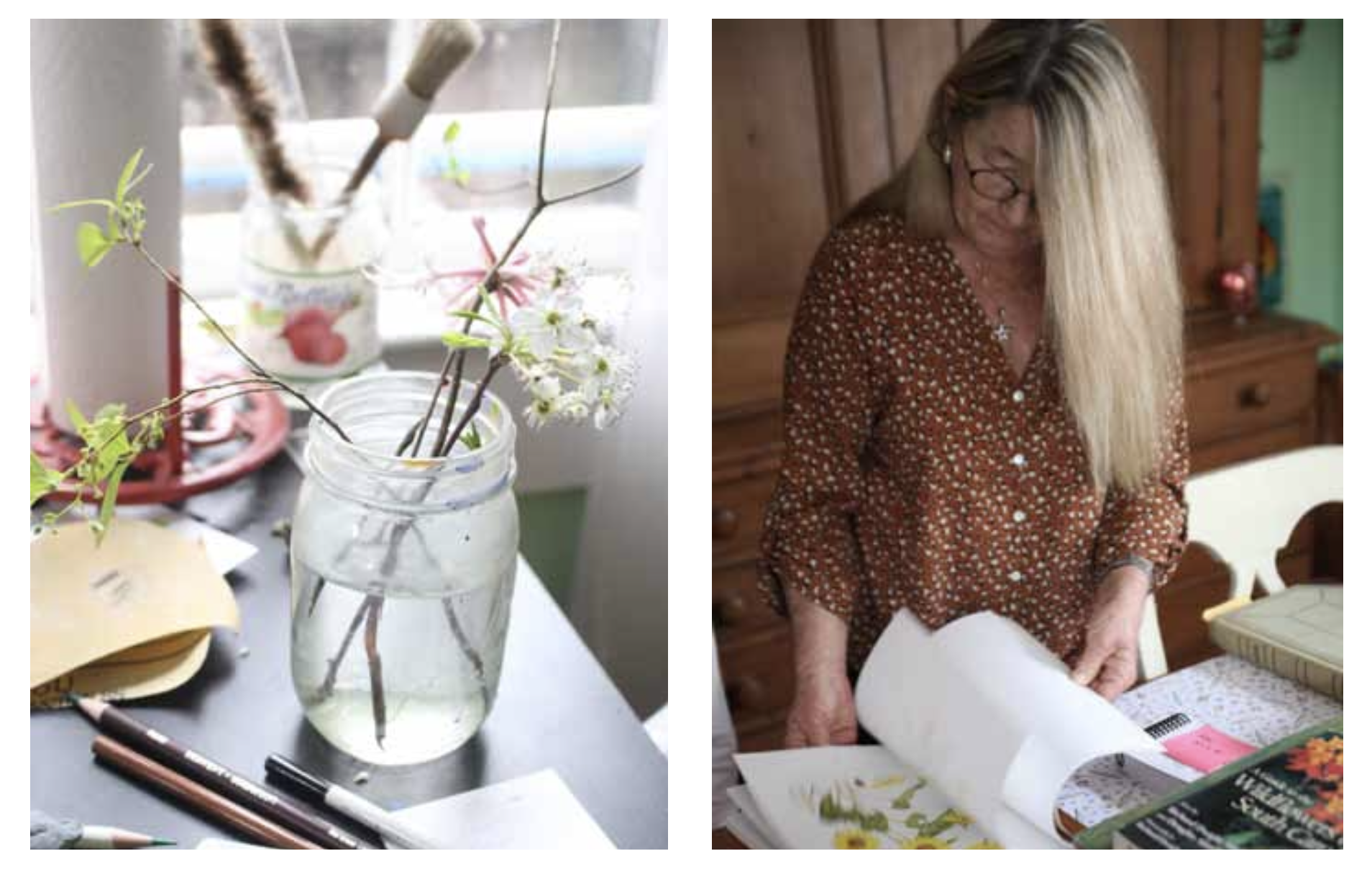Natural curiosity, artistic talent, and an insatiable desire to share makes Summerville SC’s Laura Crosby the gift that keeps on giving.
Laura Crosby is what one might call a force of nature, or rather a force for nature. And if flowers were fuel, the Summerville artist could loan the space shuttle a tank or two and still circle the earth several times over. Her energy is highly contagious, lighting up the studio where Daisy the dog keeps a watchful eye over the artist as she works. Her encyclopedic knowledge is delivered in the patois of the South Carolina midlands. The delightfully slow drawl is mesmerizing and keeps one hanging on her every word. It’s no wonder that she’s regularly recognized by students from her 28- year public school career with vivid memories of their Summerville Elementary teacher, Mrs. Crosby.
Summers spent working at a local nursery started her fascination with plants and earned her the qualifications needed to teach horticulture at MacDougall Correctional Institute in Ridgeville. Her face lights up when she describes her time working with inmates. She beams at what she remembers as “the best job I ever had in my life.”

Crosby bought the seeds and soil for the prison’s greenhouse out of her own pocket. Those enrolled in the horticulture classes for spring and summer got their own plot of land to grow vegetables. The teacher was amazed at how many inmates fell in love with gardening. “Every day, I gave them a “mystery plant” that they would research in the books I brought to learn the genus and species. I also had them draw and press each plant. Some turned out to be excellent artists.” But she didn’t want their experience to end when they were released, so she encouraged them to use their skills when they got out. At the end of the semester, she bound each inmate’s drawings and specimens together for them to remember all they learned about each one. “I used to tell them that if they found themselves in with the wrong crowd, to excuse themselves and go draw because when you draw, you’re in your own world, and the things going on around you don’t matter.” An inmate in his 50s told her he hadn’t drawn since he was in high school and had forgotten how much he loved it.” That experience has stayed with her. “Teaching is often a thankless job, but this job was so rewarding. You just have to eke out the small victories as your reward.”
That job and inspiration from English naturalist Mark Catesby fueled Crosby’s passion for drawing plants. Works by Catesby, whose years sketching and collecting plants and animals of the Eastern Coastline and The Bahamas were sadly eclipsed a century later by the better-known John James Audubon. However, it remains the best- illustrated record of flora and fauna in North America. When Crosby and her husband bought a house on a “skinny little island” in The Bahamas called Eleuthera, she realized she didn’t recognize a single species. But she did know she was walking paths that her mentor, Catesby, had trod. Curiosity piqued, the artist set out to remedy the situation. She regularly visited the Leon Levy Native Plant Preserve operated by The Bahamas National Trust. The 30-acre preserve is a research center for traditional bush medicine, a facility for indigenous plant and tree propagation, and an educational center focusing on the importance of native vegetation. “They have a fabulous botanist there, and I started sending him drawings of plants to identify for me. One day I asked if they might be interested in putting the drawings together for notecards or something to sell in their gift shop.They liked that idea, so I send them a bunch every year.” They had an idea for Crosby, offering her a job as Botanical Artist for the Levy Preserve and asking her to spend five months on the island to draw each native plant from living specimens. She accepted, but before she could begin, Covid hit, bringing its travel restrictions and complications.

Not one to sit still for long, Crosby turned to her own backyard, pressing and drawing South Carolina native species. Calling on USC’s A.C. Moore Herbarium for help identifying each plant, Crosby soon began riding her bicycle all over town looking for specimens to draw. I looked in all kinds of nooks and crannies, parking lots, parks, and nature trails. “You know, lots of what we call weeds are just plants in the wrong places. I found so many beautiful plants. But, unfortunately, with so much development going on, I worry that some of these things might soon just be gone.”
Setting herself a goal of identifying, pressing, and drawing one hundred of the area’s native species, Crosby has already amassed an impressive collection. She notes where each one is found, and the Herbarium has already determined that some have been found out of their normal range or are simply scarce. Though she has toyed with donating her collection to the Herbarium, those fortunate enough to have had a peek at her work urge her to publish the collection.
Whether her search for flora finds her in the islands or riding her bicycle around Summerville, Laura Crosby’s talents are a gift that will long be cherished by those who study plants and by those of us simply enamored of her artistry. And there is no doubt that somewhere, Mark Catesby is very proud. AM






